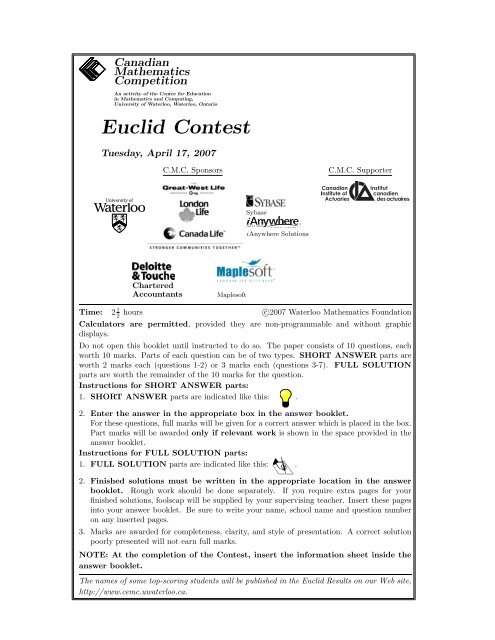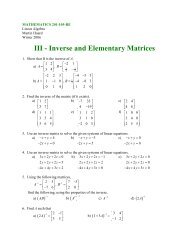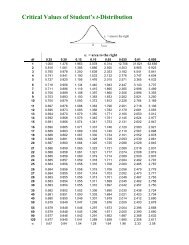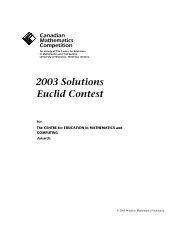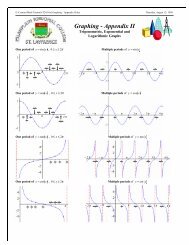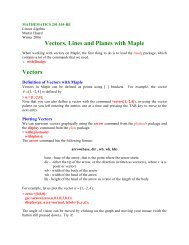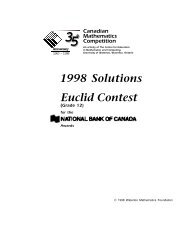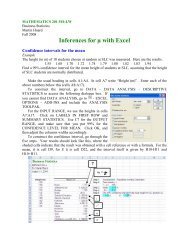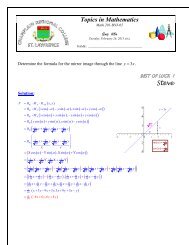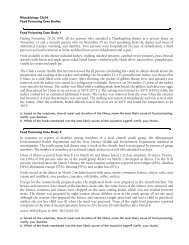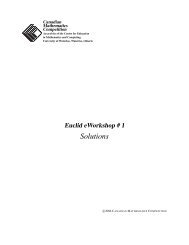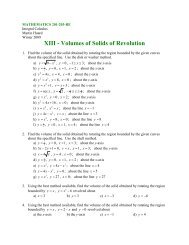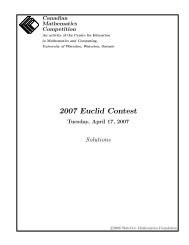Euclid Contest 2007 - CEMC - University of Waterloo
Euclid Contest 2007 - CEMC - University of Waterloo
Euclid Contest 2007 - CEMC - University of Waterloo
You also want an ePaper? Increase the reach of your titles
YUMPU automatically turns print PDFs into web optimized ePapers that Google loves.
CanadianMathematicsCompetitionAn activity <strong>of</strong> the Centre for Educationin Mathematics and Computing,<strong>University</strong> <strong>of</strong> <strong>Waterloo</strong>, <strong>Waterloo</strong>, Ontario<strong>Euclid</strong> <strong>Contest</strong>Tuesday, April 17, <strong>2007</strong>C.M.C. SponsorsC.M.C. SupporterSybaseiAnywhere SolutionsCharteredAccountantsMaples<strong>of</strong>tTime: 2 1 2hours c○<strong>2007</strong> <strong>Waterloo</strong> Mathematics FoundationCalculators are permitted, provided they are non-programmable and without graphicdisplays.Do not open this booklet until instructed to do so. The paper consists <strong>of</strong> 10 questions, eachworth 10 marks. Parts <strong>of</strong> each question can be <strong>of</strong> two types. SHORT ANSWER parts areworth 2 marks each (questions 1-2) or 3 marks each (questions 3-7). FULL SOLUTIONparts are worth the remainder <strong>of</strong> the 10 marks for the question.Instructions for SHORT ANSWER parts:1. SHORT ANSWER parts are indicated like this: .2. Enter the answer in the appropriate box in the answer booklet.For these questions, full marks will be given for a correct answer which is placed in the box.Part marks will be awarded only if relevant work is shown in the space provided in theanswer booklet.Instructions for FULL SOLUTION parts:1. FULL SOLUTION parts are indicated like this: .2. Finished solutions must be written in the appropriate location in the answerbooklet. Rough work should be done separately. If you require extra pages for yourfinished solutions, foolscap will be supplied by your supervising teacher. Insert these pagesinto your answer booklet. Be sure to write your name, school name and question numberon any inserted pages.3. Marks are awarded for completeness, clarity, and style <strong>of</strong> presentation. A correct solutionpoorly presented will not earn full marks.NOTE: At the completion <strong>of</strong> the <strong>Contest</strong>, insert the information sheet inside theanswer booklet.The names <strong>of</strong> some top-scoring students will be published in the <strong>Euclid</strong> Results on our Web site,http://www.cemc.uwaterloo.ca.
NOTES: 1. Please read the instructions on the front cover <strong>of</strong> this booklet.2. Write all answers in the answer booklet provided.3. For questions marked “ ”, full marks will be given for a correct answerplaced in the appropriate box in the answer booklet. If an incorrect answeris given, marks may be given for work shown. Students are stronglyencouraged to show their work.4. All calculations and answers should be expressed as exact numbers such as4π, 2 + √ 7, etc., except where otherwise indicated.1. (a) If the point (a − 1, a + 1) lies on the line y = 2x − 3, what is the value <strong>of</strong> a?(b) In the diagram, a line is drawn through pointsP , Q and R. If P Q = QR, what are thecoordinates <strong>of</strong> R?yRQ(0, 4)P( 3, 0)x(c) In the diagram, OA = 15, OP = 9 andP B = 4. Determine the equation <strong>of</strong> the linethrough A and B. Explain how you got youranswer.yAOPBx2. (a) In the diagram, △ABC is right-angled at Band AB = 10. If cos(∠BAC) = 513, what isthe value <strong>of</strong> tan(∠ACB)?C(b) Suppose 0 ◦ < x < 90 ◦ and 2 sin 2 x + cos 2 x = 2516. What is the value <strong>of</strong> sin x?A10B(c) In the diagram, AB = BC = 2 √ 2, CD = DE,∠CDE = 60 ◦ , and ∠EAB = 75 ◦ . Determinethe perimeter <strong>of</strong> figure ABCDE. Explain howyou got your answer.AEBCD
3. (a) The first term <strong>of</strong> a sequence is <strong>2007</strong>. Each term, starting with the second, is thesum <strong>of</strong> the cubes <strong>of</strong> the digits <strong>of</strong> the previous term. What is the <strong>2007</strong>th term?(b) Sequence A has nth term n 2 − 10n + 70.(The first three terms <strong>of</strong> sequence A are 61, 54, 49.)Sequence B is an arithmetic sequence with first term 5 and common difference 10.(The first three terms <strong>of</strong> sequence B are 5, 15, 25.)Determine all n for which the nth term <strong>of</strong> sequence A is equal to the nth term<strong>of</strong> sequence B. Explain how you got your answer.4. (a) Determine all values <strong>of</strong> x for which 2 + √ x − 2 = x − 2.(b) In the diagram, the parabola intersects thex-axis at A(−3, 0) and B(3, 0) and has itsvertex at C below the x-axis. The area <strong>of</strong>△ABC is 54. Determine the equation <strong>of</strong> theparabola. Explain how you got your answer.A ( 3, 0) B (3, 0)yxC5. (a) In the diagram, a sector <strong>of</strong> a circle withcentre O and radius 5 is shown. What is theperimeter <strong>of</strong> the sector?5AO725B(b) In the diagram, A(0, a) lies on the y-axisabove D. If the triangles AOB and BCDhave the same area, determine the value <strong>of</strong> a.Explain how you got your answer.yA (0, a)C (3, 2)D (0, 1)OB (1, 0)x
6. (a) The Little Prince lives on a spherical planetwhich has a radius <strong>of</strong> 24 km and centre O.He hovers in a helicopter (H) at a height <strong>of</strong>2 km above the surface <strong>of</strong> the planet. Fromhis position in the helicopter, what is thedistance, in kilometres, to the furthest pointon the surface <strong>of</strong> the planet that he can see?OH(b) In the diagram, points A andB are located on islands ina river full <strong>of</strong> rabid aquaticgoats. Determine the distancefrom A to B, to the nearestmetre. (Luckily, someone hasmeasured the angles shown in thediagram as well as the distancesCD and DE.)C50150 mA45 3520B70100 mED7. (a) Determine all values <strong>of</strong> x for which ( √ x) log 10 x = 100.(b) In the diagram, line segment F CG passesthrough vertex C <strong>of</strong> square ABCD, withF lying on AB extended and G lying on1AD extended. Prove thatAB = 1AF + 1GDCAG . A BF8. (a) In the 4 × 4 grid shown, three coinsare randomly placed in different squares.Determine the probability that no two coinslie in the same row or column.(b) In the diagram, the area <strong>of</strong> △ABC is 1.Trapezoid DEF G is constructed so that G isto the left <strong>of</strong> F , DE is parallel to BC,EF is parallel to AB and DG is parallel toAC. Determine the maximum possible area<strong>of</strong> trapezoid DEF G.DAEBGFC
9. The parabola y = f(x) = x 2 + bx + c has vertex P and the parabolay = g(x) = −x 2 + dx + e has vertex Q, where P and Q are distinct points.The two parabolas also intersect at P and Q.(a) Prove that 2(e − c) = bd.(b) Prove that the line through P and Q has slope 1 2 (b + d) and y-intercept 1 2(c + e).10. (a) In the diagram, the circle is tangent to XY at Yand to XZ at Z. Point T is chosen on the minorarc Y Z and a tangent to the circle is drawn at T ,cutting XY at V and XZ at W . Prove thatthe perimeter <strong>of</strong> △V XW is independent <strong>of</strong> theposition <strong>of</strong> T .(b) In the diagram, AB = 10, BC = 14, AC = 16,and M is the midpoint <strong>of</strong> BC. Various linescan be drawn through M, cutting AB (possiblyextended) at P and AC (possibly extended)at Q. Determine, with pro<strong>of</strong>, the minimumpossible perimeter <strong>of</strong> △AP Q.XAVBPYTW ZMCQ
<strong>2007</strong><strong>Euclid</strong><strong>Contest</strong>(English)For students...Canadian Mathematics CompetitionThank you for writing the <strong>2007</strong> <strong>Euclid</strong> <strong>Contest</strong>!In 2006, more than 15 000 students around the worldregistered to write the <strong>Euclid</strong> <strong>Contest</strong>.If you are graduating from secondary school, good luckin your future endeavours!If you will be returning to secondary school next year,encourage your teacher to register you for the <strong>2007</strong> CanadianOpen Mathematics Challenge, which will be written in lateNovember.Visit our websitewww.cemc.uwaterloo.cato find• More information about the Canadian OpenMathematics Challenge• Free copies <strong>of</strong> past <strong>Contest</strong>s• Workshops to help you prepare for future <strong>Contest</strong>s• Information about our publications for math enrichmentand <strong>Contest</strong> preparation• Information about careers in mathFor teachers...Visit our websitetowww.cemc.uwaterloo.ca• Obtain information about our <strong>2007</strong>/2008 <strong>Contest</strong>s• Learn about workshops and resources we <strong>of</strong>fer forteachers• Find your school results


